Digital Posters
Cancer: Preclinical & Clinical
ISMRM & SMRT Annual Meeting • 15-20 May 2021

| Concurrent 2 | 13:00 - 14:00 |
0919.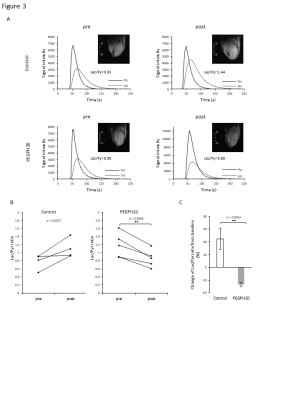 |
Hyaluronan depletion improved intratumor pO2 and sensitized tumor to radiation therapy in pancreatic cancer model mouse.
Yu Saida1, Tomohiro Seki2, Shun Kishimoto1, Yasunori Otowa1, Kota Yamashita1, Kazutoshi Yamamoto1, Nallathamby Devasahayam1, Jeffrey R. Brender1, and Murali C. Krishna1
1Radiation Biology Branch, National Cancer Institute, Bethesda, MD, United States, 2Laboratory of Pharmaceutics, Faculty of Pharmacy and Pharmaceutical Sciences, Josai University, Saitama, Japan
PEGylated human hyaluronidase (PEGPH20) has been developed to enzymatically deplete tumor hyaluronan. The purpose of this study is to investigate physiologic and metabolic changes in pancreatic adenocarcinoma xenograft after PEGPH20 treatment by using multi-modal imaging and further determine the utility of PEGPH20 as radiosensitizer. PEGPH20 significantly increased intratumor pO2 and blood volume and decreased glycolytic flux assessed by EPRI, USPIO-MRI, and hyperpolarized 13C-MRI, respectively. PEGPH20 also enhanced treatment effect of radiotherapy in vivo. The results validated the utility of the imaging methods to non-invasively monitor changes in the tumor microenvironment and predicted the radiosensitizing effect upon hyaluronan depletion.
|
|||
0920.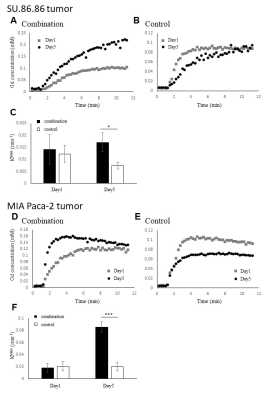 |
Multimodal molecular imaging assessment of changes in tumor microenvironment in response to combination of Evofosfamide and GEM
Yasunori Otowa1, Kota Yamashita1, Yu Saida1, Kazutoshi Yamamoto1, Jeffery R Brender1, Nallathamby Devasahayam1, Murali C. Krishna1, and Shun Kishimoto1
1National Cancer Institute, Bethesda, MD, United States
Combination of evofosfamide and chemotherapy suppress tumor growth than using these drugs alone. The purpose of this study is to detect physiologic changes in tumor-bearing mouse model in response to combination of evofosfamide and gemcitabine (GEM) using multi-modal imaging methods including DCE-MRI, blood volume imaging, and EPRI. Significantly increased perfusion, maintained blood volume, and maintained hypoxic fraction < 10 mmHg were observed after treatment with combination of evofosfamide and GEM. The results validate the utility of these imaging methods to non-invasively monitor changes in the tumor microenvironment after treatment.
|
|||
0921.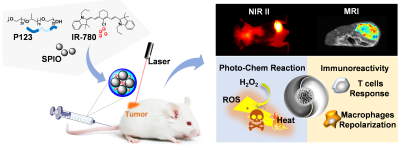 |
Iron oxide-based Enzyme Mimic Nanocomposite for Dual-Modality Imaging Guided Chem-phototherapy and Anti-tumor Immunity Against Breast Cancer
Xiuhong Guan1, Jiali Cai2, Xiangyu Xiong1, Hong Liu2, Shihui Huang2, Sheng Wang2, Chuanqi Sun1, Yi Sun3, Tianjing Zhang4, Guoxi Xie1, and Zhiyong Wang2
1Department of Biomedical Engineering, Guangzhou Medical University, Guangzhou, China, 2School of Materials Science and Engineering, Sun Yat-sen University, Guangzhou, China, 3Siemens Healthineers, Shanghai, China, 4Philips Healthcare, Guangzhou, China
Due to the high incidence and mortality, breast cancer has become the major cause of cancer death among female. This study reports a kind of functional nanocomposite, which was designed to comprises Pluronic P123 to self-assembly superparamagnetic iron oxide nanocrystals (SPIONs) and IR-780 dyes into one system, exhibiting NIR-II and MR dual-modal imaging guided chem-phototherapy and anti-tumor immunity against triple-negative breast cancer.
|
|||
0922.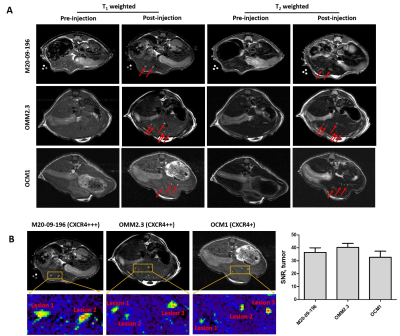 |
Precision MRI (pMRI) of Liver Metastasis enabled by Protein MRI contrast agents
Jenny Yang1, Mani Salarian2, Hua Yang3, Shanshan Tan4, Oluwatosin Y Ibhagui4, Jingjuan Qiao4, Zongxiang Gui4, and Hans E Grossniklaus3
1Chemistry, Georgia State University, Atlatna, GA, United States, 2Chemistry, Georgia State University, Atlanta, GA, United States, 3Emory University, Atlanta, GA, United States, 4Georgia State University, Atlanta, GA, United States
The liver is the most common organ for metastasis of various malignancies, especially for uveal melanoma (UM), colorectal cancer (CRC) and pancreatic ductal adenocarcinoma (PDAC). Precision medicine to chronic diseases, especially for liver cancer and metastasis, requires non-invasive precision diagnostics. Non-invasive precision imaging capable of early detection, staging and molecular subtyping/stratification of patients, is a major breakthrough. Rapid development and approval of precision medicine also requires precision imaging to evaluate drug efficacy at animal and patient levels. There is a pressing unmet medical need to develop MRI contrast agents and imaging methodologies with desired sensitivity and specificity .
|
|||
0923.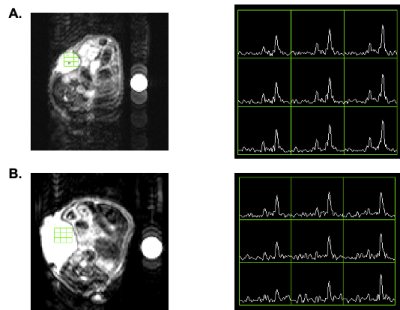 |
Imaging ascorbate-mediated oxidative stress in PDX models of pancreatic cancer
Nathaniel Kim1, Arsen Mamakhantan1, Kristin Granlund1, Elisa de Stanchina2, Manish Shah3, Lewis Cantley4, and Kayvan R. Keshari1
1Department of Radiology, Memorial Sloan Kettering Cancer Center, New York, NY, United States, 2Antitumor Assessment Core Facility, Molecular Pharmacology Program, Memorial Sloan Kettering Cancer Center, New York, NY, United States, 3Weill Cornell Medicine, New York-Presbyterian Hospital, New York, NY, United States, 4Meyer Cancer Center, Department of Medicine, Well Cornell Medical College, New York, NY, United States
We investigated hyperpolarized [1-13C] dehydroascorbic acid (HP DHA) as an imaging agent for probing oxidative stress in patient derived xenograft models (PDXs) of pancreatic cancer. By increasing the T1 via D2O solvation and increasing the dose administered via awake mouse injection, conversion of DHA to ascorbate was readily observed in KRAS and BRCA mutant cancers. HP DHA was then used to characterize oxidative stress in these PDX models and their biochemical mechanism of response to ascorbate therapy. Changes in DHA/ascorbate metabolism were measured in these tumor models, demonstrating a proof of concept method for assessing ascorbate therapy in pancreatic cancer.
|
|||
0924.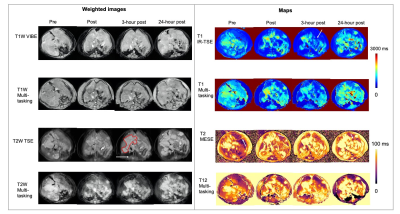 |
3D Free-breathing Multitasking T1-T2 Mapping in Small Animals on a 3-Tesla System: A Preliminary Study on a Murine Model with Liver Metastasis
Nan Wang1, Jingjuan Qiao2, Zhijun Wang3, Pei Han1,4, Hsu-Lei Lee1, Sen Ma1, Hui Han1, Zhaoyang Fan1, Anthony G. Christodoulou1, Ekihiro Seki3, Stephen Pandol5, Debiao Li1, Jenny Yang2, and Yibin Xie1
1Biomedical Imaging Research Institute, Cedars-Sinai Medical Center, Los Angeles, CA, United States, 2Chemistry Department, Georgia State University, Atlanta, GA, United States, 3Department of Medicine, Cedars-Sinai Medical Center, Los Angeles, CA, United States, 4Bioengineering, University of California, Los Angeles, Los Angeles, CA, United States, 5Division of Digestive and Liver Diseases, Cedars-Sinai Medical Center, Los Angeles, CA, United States
MRI is a promising tool for the non-invasive study of animal model, but continues to face technical challenges. In this work, a Multitasking T1-T2 mapping technique was proposed for mouse abdominal imaging on 3T, which achieved 3D coverage, motion-resolved acquisition, and simultaneous T1 T2 mapping within 10 minutes. The study was performed on a murine model with liver metastasis of colorectal cancer. Data at multiple time points after tumor injection were acquired with different contrast agent, Eovist and ProCA.collagen1. The results demonstrated that 10-min Multitasking technique produced improved images with clear tumor delineation compared to conventional MRI series (50 minutes).
|
|||
0925.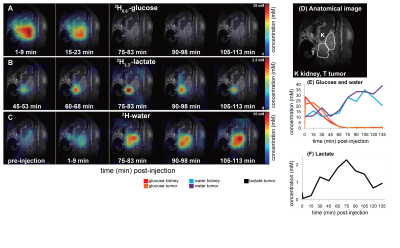 |
Deuterium metabolic imaging (DMI) of glucose highlights pancreatic cancers in two mice models
Stefan Markovic1, Tangi Roussel2, Keren Sasson3, Dina Preise3, Lilach Agemi3, Avigdor Scherz3, and Lucio Frydman1
1Department of Chemical and Biological Physics, Weizmann Institute of Science, Rehovot, Israel, 2Center for Magnetic Resonance in Biology and Medicine, Marseille, France, 3The Moross Integrated Cancer Research Center, Weizmann Institute of Science, Rehovot, Israel
Deuterium Metabolic Imaging (DMI) was used to follow metabolism in two pancreatic cancer mouse models, after tail-vein administration of 2H6,6’-glucose. Metabolic maps for the glucose and for its metabolic products 2H3,3’-lactate and 2H-water were measured over a time course of 2 h by 2H chemical shift imaging (CSI) at 15.2 T. Abdominal images exhibited sharp and specific lactate signals, which generated exclusively in the tumors. Thus, DMI may open valuable opportunities for non-invasively imaging pancreatic cancer –including its diagnosis and treatment.
|
|||
0926.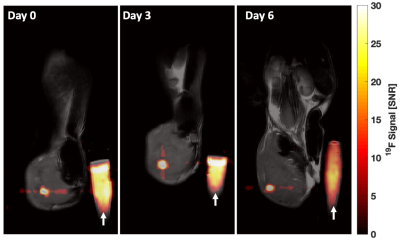 |
In-Vivo Cell Tracking of Murine Natural Killer Cells in Lymphoma by Fluorine-19 MRI
Lawrence Lechuga1, Sean B Fain1,2,3,4, Christian M Capitini3,4,5, and Matthew H Forsberg5
1Medical Physics, University of Wisconsin, Madison, Madison, WI, United States, 2Radiology, University of Wisconsin, Madison, Madison, WI, United States, 3Biomedical Engineering, University of Wisconsin, Madison, Madison, WI, United States, 4Carbone Cancer Center, University of Wisconsin, Madison, Madison, WI, United States, 5Pediatrics, University of Wisconsin, Madison, Madison, WI, United States
Fluorine-19 (19F) MRI can monitor various cell types in vivo for days to weeks after injection of 19F-labeled cells. To establish cell viability Green Fluorescent Protein (GFP+) murine natural killer (NK) cells were labeled ex vivo using red-fluorescent perfluoropolyether (PFPE-red) and delivered intratumorally into 3 lymphoma-bearing mice. Flow cytometry validated that the infused NK cells retain their 19F label out to 6 days post-injection (PI). Cells were then tracked and quantified via 1H/19F MRI out to 6 days PI. Quantification of the infused cells indicate 87% and 70% were detectible at days 0 and 6, respectively.
|
|||
0927.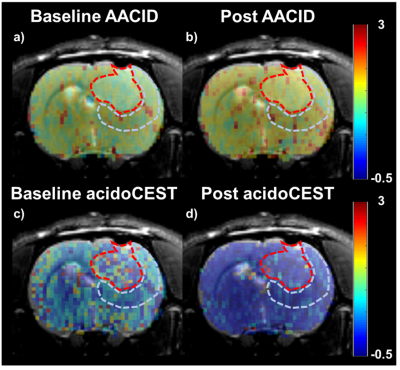 |
Comparison of Tumour pH Environment and Glycolysis Measurements in a C6 Rat Model of Glioma
Qi Qi1,2,3, Matthew Fox1,4, Robert Bartha2,5,6, Miranda Bellyou5, Lise Desjardins7, Lisa Hoffman1,2,8, Alex Li5, Andrew McClennan1,2, Ting Yim Lee1,2,3,5,6, and Jonathan D Thiessen1,2,3,6
1Lawson Imaging, Lawson Health Research Institute, London, ON, Canada, 2Medical Biophysics, Western University, London, ON, Canada, 3Molecular Imaging, Western University, London, ON, Canada, 4Physics and Astronomy, Western University, London, ON, Canada, 5Robart Research Institute, London, ON, Canada, 6Medical Imaging, Western University, London, ON, Canada, 7Lawson Health Research Institute, London, ON, Canada, 8Anatomy and Cell Biology, Western University, London, ON, Canada
There is an intrinsic relationship between tumour glycolysis and its pH environment. CEST MRI enables the detection of tumour pH in both intra- (pHi) and extracellular (pHe) spaces with AACID and acidoCEST methods. Kinetic analysis of dynamic FDG-PET can provide an accurate measurement of tumour glycolysis. This study demonstrates the capability of simultaneous measurements of pHi and pHe using CEST MRI, providing a more complete picture of the tumour pH environment, and explores the intrinsic relationship between tumour glycolysis and its pH environment.
|
|||
0928.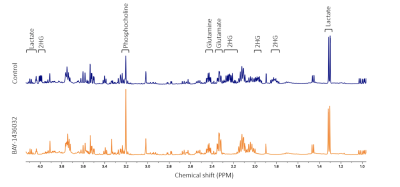 |
MRS based biomarkers of IDH1 mutant glioma response to the BAY-1436032 IDH inhibitor
Donghyun Hong1, Georgios Batsios1, Pavithra Viswanath1, Anne Marie Gillespie1, Russell O Pieper2,3, Joseph Costello2, and Sabrina M Ronen 1,3
1Department of Radiology and Biomedical Imaging, University of California, San Francisco, San Francisco, CA, United States, 2Department of Neurological Surgery, University of California San Francisco, San Francisco, CA, United States, 3Brain Tumor Research Center, University of California San Francisco, San Francisco, CA, United States
Mutant IDH1 inhibitor treatment is currently in clinical trials for glioma patients. However, to date, treatment does not result in tumor shrinkage. Therefore, in vivo biomarkers are needed to assess early therapeutic response. Here we treated mutant IDH1-expressing cells with the emerging inhibitor BAY-1436032. Using 1H MRS we found a significant decrease in 2-hydroxyglutarate that was accompanied by an increase in glutamate and phosphocholine, and using 13C MRS we detected a significant increase in glutamate produced from hyperpolarized [1-13C]α-ketoglutarate.
|
|||
0929.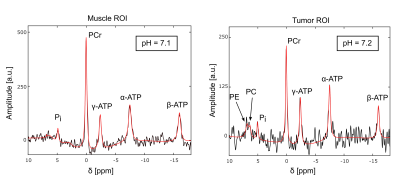 |
31P MRSI in tumor-bearing mice at 9.4T
Vanessa L. Franke1, Justyna Platek1, Philip S. Boyd1, Stephanie Laier2, Karin Mueller-Decker2, Andrey Glinka3, Mark E. Ladd1, Steffen Goerke1, Peter Bachert1, and Andreas Korzowski1
1Division of Medical Physics in Radiology, German Cancer Research Center (DKFZ), Heidelberg, Germany, 2Center for Preclinical Research, Core Facility Tumor Models, German Cancer Research Center (DKFZ), Heidelberg, Germany, 3Division of Molecular Embryology, German Cancer Research Center (DKFZ), Heidelberg, Germany
31P MRSI allows for the non-invasive investigation of energy metabolism in vivo and is therewith of interest for research on novel therapies for cancer. The purpose of this study was to investigate suitable acquisition strategies for 31P MRSI in tumor-bearing mice at B0=9.4T in order to monitor in future studies effects of novel therapies affecting energy metabolism and pH values. 31P MRSI datasets with a spatial resolution of (2.5x2.5x7.5) mm³ obtained in 50 minutes enabled the quantification of signals in diseased tissue, while maintaining acceptable separation to healthy tissue.
|
|||
0930.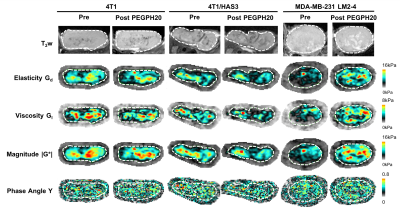 |
MR elastography reveals a marked increase in breast cancer viscoelasticity in vivo following hyaluronan degradation by PEGPH20
Emma L. Reeves1, Jin Li1,2, Konstantinos Zormpas-Petridis1, Jessica K. R. Boult1, James Sullivan1,3, Craig Cummings1, Barbara Blouw4, David Kang4, Ralph Sinkus5, Yann Jamin1, Jeffrey C. Bamber1, and Simon P. Robinson1
1Radiotherapy & Imaging, Institute of Cancer Research, London, United Kingdom, 2Institutes of Brain Science, Fudan University, Shanghai, China, 3Royal Marsden NHS Foundation Trust, Sutton, United Kingdom, 4Halozyme Therapeutics, San Diego, CA, United States, 5Division of Imaging Sciences and Biomedical Engineering, King's Health Partners, St Thomas's Hospital, London, United Kingdom
We hypothesised that hyaluronan (HA) degradation by PEGPH20 may alter tumour viscoelasticity measured by MR elastography (MRE). MRE was performed before and after PEGPH20 in three orthotopic breast tumour models (4T1, 4T1/HAS3 and MDA-MB-231 LM2-4). Viscoelastic properties did not change following PEGPH20 in 4T1 and 4T1/HAS3 tumours. However, a dramatic PEGPH20-induced increase in tumour viscoelasticity was seen in MDA-MB-231 LM2-4 tumours, likely the result of collagen network rearrangement and not HA degradation alone. Although MRE is unlikely to provide a robust biomarker of PEGPH20 response, these data clearly demonstrate that MRE-derived biomarkers can inform on increased tumour stiffness in vivo.
|
|||
0931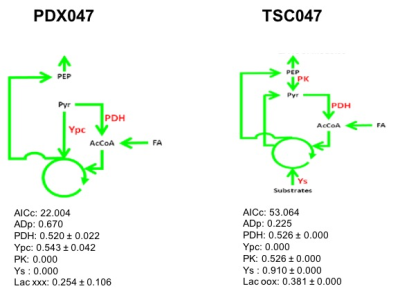 |
Metabolomic Characterization of renal cell carcinoma patient-derived xenografts and derived Tissue Slice Cultures Video Permission Withheld
Deepti Upadhyay1, Jinny Sun1, Joao Piraquive Agudelo1, Hongjuan Zhao2, Rosalie Nolley2, Robert Bok1, James D. Brooks2, Donna M. Peehl1, John Kurhanewicz1, and Renuka Sriram1
1Department of Radiology and Biomedical Imaging, University of California, San Francisco, San Francisco, CA, United States, 2Department of Urology, Stanford University, Stanford, CA, United States
NMR based stable isotope resolved metabolomics was used for the metabolic characterization of renal cell carcinoma (RCC) patient-derived xenografts (PDXs) and their derived tissue slice cultures (TSCs). Targeted metabolomics and [U-13C] glucose-labeling studies indicate metabolic heterogeneity among PDXs of various pathologic and clinical stages. Both PDXs and TSCs exhibit high glycolytic rate and low TCA activity characteristic of RCC. However, there is variability in glycolytic rate and TCA activity among different PDXs and their corresponding TSCs.
|
|||
0932.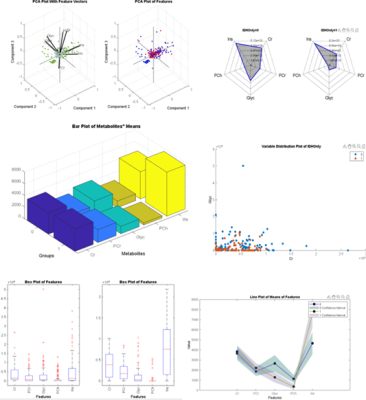 |
Glioma Genetic Diagnosis Software for Detection of IDH and TERTp Mutations based on 1H MR Spectroscopy and Mass Spectrometry
Abdullah Bas1, Banu Sacli-Bilmez1, Gokce Hale Hatay1, Alpay Ozcan2,3, Cansu Levi4, Ayca Ersen Danyeli3,5, Ozge Can3,6, Cengiz Yakicier3,7, M.Necmettin Pamir3,8, Koray Ozduman3,8, Alp Dincer3,9, and Esin Ozturk-Isik1,3
1Institute of Biomedical Engineering, Bogazici University, İstanbul, Turkey, 2Electrical and Electronics Engineering, Bogazici University, Istanbul, Turkey, 3Center for Neuroradiological Applications and Reseach, Acibadem Mehmet Ali Aydinlar University, Istanbul, Turkey, 4Department of Medical Biochemistry, Acibadem Mehmet Ali Aydinlar University, Istanbul, Turkey, 5Department of Medical Pathology, Acibadem Mehmet Ali Aydinlar University, Istanbul, Turkey, 6Department of Medical Engineering, Acibadem Mehmet Ali Aydinlar University, Istanbul, Turkey, 7Department of Molecular Biology and Genetics, Acibadem Mehmet Ali Aydinlar University, Istanbul, Turkey, 8Department of Neurosurgery, Acibadem Mehmet Ali Aydinlar University, Istanbul, Turkey, 9Department of Radiology, Acıbadem Mehmet Ali Aydinlar University, Istanbul, Turkey
Glioma Genetic Diagnosis Software, a clinical decision support tool for non-invasive detection of isocitrate dehydrogenase (IDH) and telomerase reverse transcriptase promoter (TERTp) mutations in gliomas using proton magnetic resonance spectroscopy (1H-MRS) and liquid chromatography-mass spectrometry (LC-MS/MS), was developed in this study. The machine-learning models were trained with the data of 237 gliomas. IDH mutation was identified with 87.04% and of 92.70% accuracies, and TERTp mutation in IDH wildtype gliomas was identified with 87.53% and 85.96% accuracies, using 1H-MRS and MS, respectively. The software provides data visualization and enables the users to train their own models.
|
|||
0933.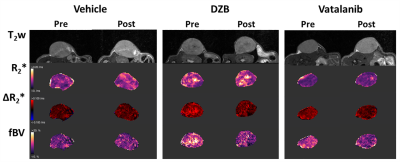 |
Tumour vascular response to the FGFR inhibitor derazantinib assessed using susceptibility-contrast MRI with ferumoxytol
Jessica K.R. Boult1, Mahmoud El Shemerly2, Felix Bachmann2, Laurenz Kellenberger2, Heidi Lane2, Paul McSheehy2, and Simon P. Robinson1
1The Institute of Cancer Research, Sutton, United Kingdom, 2Basilea Pharmaceutica International Ltd, Basel 4005, Switzerland
Derazantinib (DZB), a FGFR inhibitor, has displayed potential anti-angiogenic effects in biochemical assays. In this study, we used in vitro and in vivo assays to explore this activity. Proliferation of human umbilical vein endothelial cells, their pVEGFR expression and downstream signalling, and vascular permeability in mouse skin are dose-dependently supressed by DZB. Susceptibility-contrast MRI using ferumoxytol demonstrated a reduction in fractional blood volume in subcutaneous colorectal cancer xenografts treated with DZB for 48h. This anti-angiogenic effect may be a relevant component of the activity of DZB in tumours bearing FGFR aberrations and may facilitate clinical activity against other solid tumours.
|
|||
0934.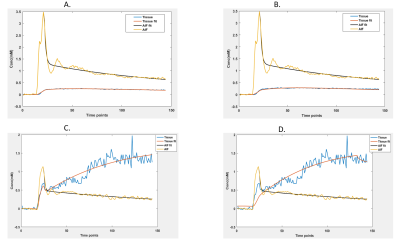 |
Evaluating the utility of DCE-MRI in differentiating brain tumours using the extended Tofts and the Shutter Speed Model
Sourav Bhaduri1, Samantha Mills2, Mark Radon2, Michael Jenkinson3, and Harish Poptani1
1Department of Molecular and Clinical Cancer Medicine, University of Liverpool, Liverpool, United Kingdom, 2Department of Neuroradiology, The Walton Centre NHS Foundation Trust, Liverpool, United Kingdom, 3Department of Neurosurgery, The Walton Centre NHS Foundation Trust, Liverpool, United Kingdom
We demonstrate the potential utility of DCE-MRI derived pharmacokinetic parameters in differentiating brain tumour types using the extended Tofts and the Shutter Speed Model. Results show an increasing pattern in Ktrans, ve, vp estimates in GBM and metastasis compared to primary central nervous system lymphoma (PCNSL). The τi estimate in GBM was the lowest, while it was highest in PCNSL.
|
|||
0935.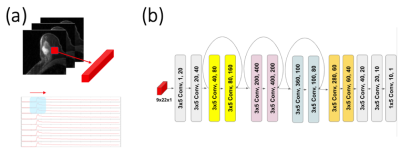 |
Estimation of capillary level input function for abbreviated breast Dynamic Contrast-Enhanced MRI using deep learning approach
Jonghyun Bae1,2,3, Zhengnan Huang1,2,3, Florian Knoll2,3, Krzysztof Geras2,3, Terlika Sood2,3, Laura Heacock2,3, Linda Moy2,3, Li Feng4, and Sungheon Gene Kim5
1NYU School of Medicine, New York, NY, United States, 2Center for Advanced Imaging Innovation and Research, New York, NY, United States, 3Center for Biomedical Imaging, NYU, New York, NY, United States, 4Icahn School of Medicine at Mount Sinai, New York, NY, United States, 5Weill Cornell Medicine, New York, NY, United States
This study proposes a deep learning approach to estimate the capillary level input function(CIF) for contrast kinetic model analysis of dynamic contrast enhanced (DCE)-MRI data. Estimation of the CIF for each voxel eliminates the need for the arterial input function and allows automatic end-to-end analysis. We hypothesize that the CIF serves as a more accurate input function that could yield accurate kinetic parameter estimation, which can be used for the diagnosis between the malignant and the benign cancer in the clinical setting. This hypothesis has been tested with a numerical simulation and breast MRI data from an abbreviated exam.
|
|||
0936.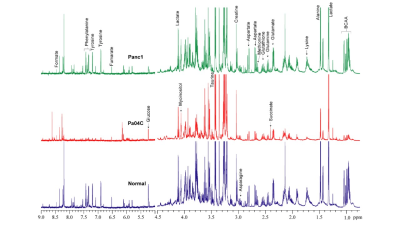 |
Commonality and complexity of systemic metabolic dysregulation caused by cancer and cancer-induced cachexia
Santosh Kumar Bharti1, Raj Kumar Sharma1, Paul T Winnard1, Marie-France Penet1, and Zaver M. Bhujwalla1,2,3
1Div. of Cancer Imaging Research, The Russell H. Morgan Dept of Radiology and Radiological Science, The Johns Hopkins University School of Medicine, Baltimore, MD, United States, 2Sidney Kimmel Comprehensive Cancer Center, The Johns Hopkins University School of Medicine, Baltimore, MD, United States, 3Radiation Oncology and Molecular Radiation Sciences, The Johns Hopkins University School of Medicine, Baltimore, MD, United States
In addition to anorexia, fat and muscle tissue wasting, psychological distress, lower tolerance to chemotherapy, and a poor quality of life, cachexia causes profound metabolic dysregulation in cancer patients that affects multiple organs. Here, for the first time, we have characterized metabolic changes in the spleen, liver, pancreas, lung, heart and kidney induced by pancreatic cancer xenografts to expand our understanding of the metabolic dysregulation caused by cachexia. These results highlight the systemic changes in metabolism that occur with cancer and with cancer induced cachexia that may lead to the development of early biomarkers as well to metabolic treatment strategies.
|
|||
0937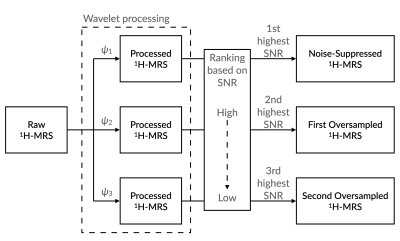 |
Wavelet Oversampling for Imbalance Childhood Brain Tumour Classification Video Permission Withheld
Dadi Zhao1,2, James T. Grist1,2, Heather E.L. Rose1,2, Yu Sun1,2, and Andrew C. Peet1,2
1Institute of Cancer and Genomic Sciences, University of Birmingham, Birmingham, United Kingdom, 2Department of Oncology, Birmingham Children's Hospital, Birmingham, United Kingdom
Classifying imbalance childhood brain tumours through 1H-MRS metabolite profiles remains a challenging problem. We presented an alternative oversampling method, wavelet oversampling (WvOS). Different from the classic Synthetic Minority Oversampling TEchnique that oversamples the metabolite profiles, WvOS used the wavelet processed 1H-MRS as the oversampled 1H-MRS, followed by quantification and classification. As the result, WvOS can provide dramatically better classification performance than non-oversampled or classic oversampled metabolite profiles. An optimal balanced classification accuracy is achieved as 96% and 72% from 84% and 52% for the 1.5T and 3T cohorts of childhood brain tumours, respectively.
|
|||
0938.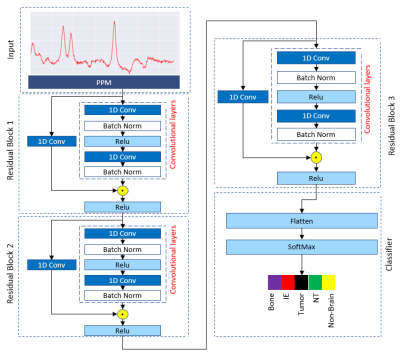 |
Tumorous Tissue Characterization in Diffuse Glioma Based on 1H-MRS Data Employing 1D Convolutional Neural Networks
Farzad Alizadeh1,2, Anahita Fathi Kazerooni3,4, Hanieh Bahrampour5, Hanieh Mobarak Salari1,2, and Hamidreza Saligheh Rad1,2
1Department of Medical Physics and Biomedical Engineering, Tehran university of Medical Science, Tehran, Iran (Islamic Republic of), 2Quantitative MR Imaging and Spectroscopy Group, Research Center for Molecular and Cellular Imaging, Tehran, Iran (Islamic Republic of), 3Center for Biomedical Image Computing and Analytics (CBICA), University of Pennsylvania, Philadelphia, PA, United States, 4Department of Radiology, Perelman School of Medicine, University of Pennsylvania, Philadelphia, PA, United States, 5Biomaterials Engineering, School of Metallurgy and Materials Engineering, Iran University of Science and Technology, Tehran, Iran (Islamic Republic of)
Characterization of intra-tumour subregions in diffuse gliomas helps to guide biopsy procedure and to determine extent of tumour infiltration in the brain tissues. Conventional MRI cannot accurately differentiate intra-tumour subregions, including the most active tumour component and infiltrated edema (IE) from each other and from the normal tissue (NT). In this work, we explore the potential of differentiation of brain tumorous tissue subregions (tumour core, infiltrated edema, normal tissue, bone, and non-brain areas) based on 1H-MRS data using artificial intelligence (AI) techniques.
|
The International Society for Magnetic Resonance in Medicine is accredited by the Accreditation Council for Continuing Medical Education to provide continuing medical education for physicians.